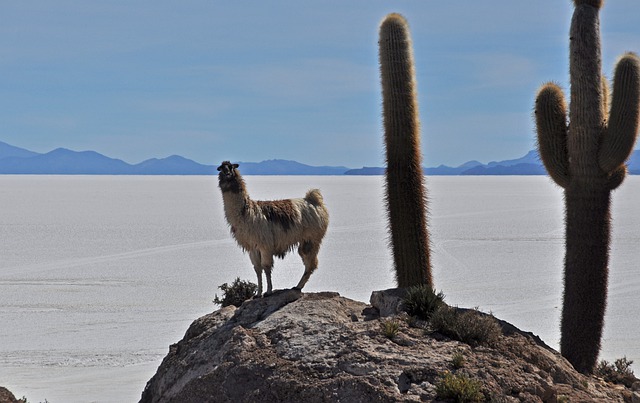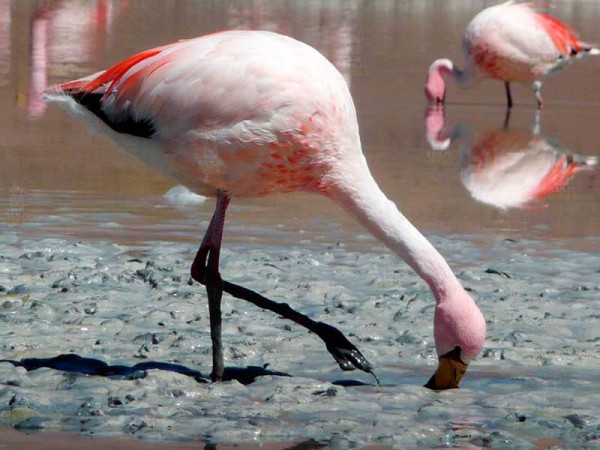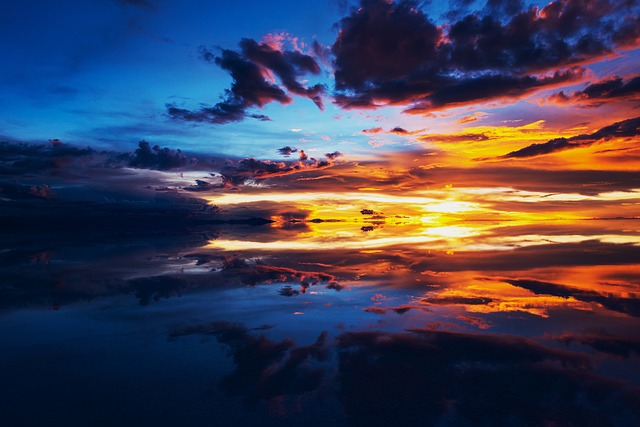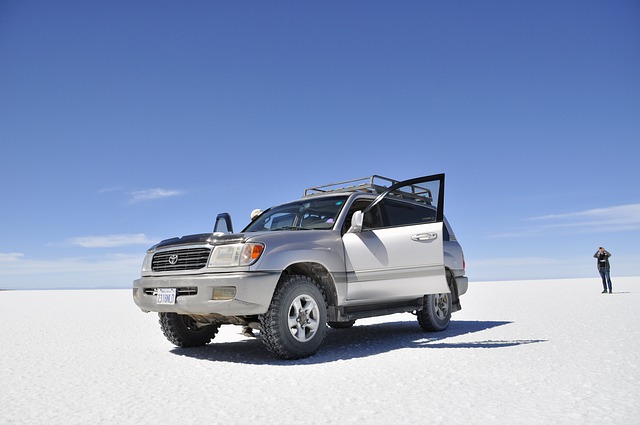Image by Yolanda Coervers from Pixabay
As a local tour company specializing in tours to Salar de Uyuni (Bolivian Salt Flats) we are well-suited to write this concise but updated guide for first-time visitors.
Disclaimer: despite being a local tour company based in Bolivia, the information below was written in an unbiased and general way with informational purposes for every visitor to Uyuni whether they become our customers or not.
What is Salar de Uyuni?
Salar de Uyuni is the name used to refer to the Bolivian Salt Flats located near the city of Uyuni in southwest Bolivia, hence the name Salar de Uyuni = Salt Flats of Uyuni.
Salar de Uyuni is approximately 10.000 Sq. Km. (3.860 square miles) which is why it can be seen from outer space. It was formed when a prehistoric lake known as Lago Minchin dried up in the lowest basin of what is now the Bolivian Altiplano (the highlands located between two Andean ranges not so far from the pacific coast) leaving massive quantities of salt.
Where is Salar de Uyuni (Uyuni Salt Flats) located?
As mentioned, it is located in the southwest of the Bolivian Altiplano in the heart of South America not far from northern Chile, which is why some people may get confused and assert that it’s located in the Atacama desert or even within Chilean territory which is not the case at all. The closest city to the actual Salt Flats is Uyuni (pop. ~ 30.000) which is a former mining town with links to the nearby bigger city of Potosi (pop. ~800K) and Sucre, the official capital of Bolivia.
How to get there?
In order to get to/tour Salar de Uyuni, it is advisable to use the city of Uyuni as a base. Being a fairly large town, Uyuni has a domestic airport, modern roads leading to it from the larger cities of Potosi, Oruro and La Paz (via Oruro) and a train station (not currently working as of Aug 2022). Most travelers will first get to La Paz which is Bolivia’s administrative capital and the base for tourism in the country.
From La Paz: As of Aug 2022, the only airline covering this route is Boliviana de Aviación with indirect flights on Sundays, Wednesdays and Fridays (via Cochabamba). Return on the same days. However, buses run every night between 7 and 8 PM from the La Paz bus terminal. The most recommended are Todo Turismo, Titicaca and Trans Omar (all with WC and comfortable seats) but there are other smaller companies in case tickets are sold out which is unlikely unless on a national holiday. You can also join one of our overland tours from La Paz to Uyuni if you would like to see the beautiful places in between.
From Oruro: Several buses run daily but are often unreliable as they may or may not depart depending on how full they get. If you definitely need to get to Uyuni from Oruro by bus, head over to the terminal and you will find one. Please note that unlike La Paz, there are no nightly buses. You can also find shared taxis known as “rapiditos” (i.e. ‘the fast ones’) which are just that, shared taxis that usually get to their destination much faster than buses but can sometimes be dangerous; they leave whenever full. Another alternative (not running as of Aug 2022) is the scenic and pleasant train ride (if coming from La Paz, get to Oruro by bus first). We will update when trains run again. However, do not count on them running daily (they never have).
From Sucre & Potosi: The main option is the public bus which often does not have a toilet but runs frequently. Head over to the terminal de buses and you will find one leaving every few hours. From the same terminal you may also find the ‘rapiditos’ shared taxis.
From Santa Cruz & Cochabamba: There is no direct road from either city so we advise against traveling by land unless touring other cities/places on the way. There are several, daily flights from Santa Cruz to Cochabamba (as from La Paz) as it is a city located in the heart of Bolivia. As mentioned above, there are three, weekly flights from Cochabamba to Uyuni with Boliviana de Aviacion.
From Chile (Calama, San Pedro de Atacama, Arica, Iquique): Being located not far from the Chilean border, one may think that it is easy to get from northern Chile to Salar de Uyuni. Unfortunately, it is not. Due to the remote settings and the western and remote Andes range, the terrain is unforgiving and extense making it hard to pave roads in the region. The best way to get to/tour Salar de Uyuni from northern Chile is by joining a multi-day tour that typically begins in San Pedro de Atacama. You can join one of our tours from San Pedro de Atacama or Arica as well.
What to do in Salar de Uyuni?
Tour the Salt Flats on a 4×4 jeep, take fun, deep-perspective photos, hike Incahuasi Island (a picturesque, rocky outcrop located in the middle of the Salt Flats) and have a picnic in the middle of the Salar. Most people will add at least two more days to the full day touring the salt flats and visit the more remote Eduardo Avaroa Reserve which boasts dramatic Andean landscapes, colored lagoons, wildlife and steaming geysers.



How long should you visit?
One day as a minimum (full day Salar de Uyuni tour). However, as mentioned, most people will budget one day to visit the Salt Flats plus two more days in the southwestern region including Eduardo Avaroa Reserve. If you are short of time or if your interest is only to see the amazing salt flats, then one (or ideally, two) full day in the salt flats will suffice. If you are headed for northern Chile, then do a three-day tour without a return to Uyuni. If you can spare a few more days and plan to start in La Paz like most people, you can travel overland visiting the amazing places such as Sajama National Park on our popular 5-Day tour from La Paz to Uyuni or even more days such as in our San Pedro de Atacama to Arica via Uyuni (6 days) or La Paz to Tupiza via Uyuni (7 days) tours. This way, you save yourself the trip to the city of Uyuni by plane or overnight bus.
When to visit Salar de Uyuni?
This is a tricky one. If you want to visit during the ‘dry season’ which is when the surface of the Salt Flats is dry and you can easily tour all over, then visit between the months of May to November. You have mostly clear and sunny days during this period but temperatures can reach -10 to -15 C. (14-5 F.) in the desert some mornings and nights, especially during the winter months of June through August. In recent years, many people wish to experience the ‘mirror effect’ which is a surreal effect caused by the flooding of the surface due to the rains during the months of December through April, the ‘rainy season’. While it is completely possible to visit during the rainy season, you will not be able to reach other spots such as Incahuasi Island (the cactus island), the northern part of the Salt Flats (Volcan Thunupa) and expect more challenging roads in the desert.

Recommended tour companies
These are some recommended companies based on local knowledge and travelers’ reports:
Budget, group tours: Quechua Connection,
Luxury, private tours: Crillon Tours
Mid-range, private and small group tours: Banjo Tours (yes, that’s us)
Miscellaneous advice/information
- Many websites/travelers will suggest that you travel to Uyuni and book a tour once you get there in order to get the best prices. While this may be somewhat true, we advise against it unless you have a lot of time to get there at least a day in advance and do your research. Most likely, if you do get there on the same day of your tour and look for a company, you may end up booking with one and being put into another group that needs whatever the size of your party is in order to fill their remaining seats. What’s more, you have no power over the quality of their service as they may or may not be the operators so you will be at their mercy unless again, you have done previous research. You also run the risk of not finding a spot with your preferred company, so just do your research and book in advance.
- Choose when you want to visit wisely. The last thing you want is to travel so far in order to see something different than what you expected. See our ‘When to visit…’ section above
- Keep in mind that this is remote Bolivia (one of the most remote countries in the continent, if not the most). You will not find modern coaches on paved roads waiting for their next group. It can be rough traveling on the bumpy, desert tracks which is why choosing a reliable operator is most important. Everybody wants to save money, but if you just take that into account, you may end up in the back seat of an old jeep inhaling the fumes or cramped behind the fold-up seats watching outside behind a blurry window for three or more days. In this case, the smaller the group, the better (and safer).
- Don’t expect modern comforts such as WiFi or central heating in most places (this is remote, rural Bolivia). Fortunately, a few modern – and unique – hotels offer the opportunity to experience a stay in a salt room with more modern comforts and comfy rooms. Book in advance though.
- Bolivia has a long way to go in terms of protecting its natural assets, so you may not see many trash/rubbish cans/bins in town or out in nature. Very few signs and park rangers as well. Be a responsible traveler and avoid getting close to wildlife and take everything with you. Strive to leave the smallest footprint as possible so that future generations can enjoy this beautiful part of planet earth.


Mostly comprehensive information, even better if accommodation choices are also introduced.